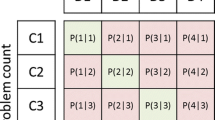Abstract
Self-Organizing Networks (SON) aim to automate network Operation & Maintenance tasks. SONs comprise self-configuration, self-optimization and self-healing. Within self-healing, root cause analysis, i.e. diagnosis of the cause of the network problems, is one of the most difficult tasks. To automate diagnosis, Data Mining (DM) algorithms over sets of solved troubleshooting cases can be applied in order to use Knowledge Based Systems. Data reduction is part of the DM process, where large time-dependent matrices of Performance Indicators (PIs) are transformed into time-independent vectors of values. In this work, an algorithm for data reduction is proposed, which is based on detecting the time intervals when the service of an LTE eNodeB is degraded and aggregating the values of the time dependent PIs for those intervals. The results show that the detecting capability of the algorithm is higher than other proposed solutions, and that a high volume reduction factor can be achieved.






Similar content being viewed by others
References
3GPP (2012). Telecommunication management; Self-Organizing Networks (SON); Concepts and requirements. Third Generation Partnership Project, TS 32.500 edition.
Szilagyi, P., & Novaczki, S. (2012). An automatic detection and diagnosis framework for mobile communication systems. IEEE Transactions on Network and Service Management, 9(2), 184–197.
Barco, R., Díez, L., Wille, V., & Lázaro, P. (2009). Automatic diagnosis of mobile communication networks under imprecise parameters. Expert systems with Applications., 36(1), 489–500.
Bennacer, L., Ciavaglia, L., Chibani, A., Amirat, Y., & Mellouk, A. (2012). Optimization of fault diagnosis based on the combination of bayesian networks and case-based reasoning. In IEEE Network Operations and Management Symposium (NOMS).
Khatib, E. J., Barco, R., Gómez-Andrades, A., & Serrano, I. (2016). Diagnosis based on genetic fuzzy algorithms for LTE self-healing. IEEE Transactions on Vehicular Technology, 65(3), 1639–1651.
Khatib, E. J., Barco, R., Serrano, I., & Muñoz, P. (2014). LTE performance data reduction for knowledge acquisition. In Globecom 2014 (pp. 270–274).
Novczki, S., & Gajic, B. (2015). Fixed-resolution growing neural gas for clustering the mobile networks data, volume 517 of communications in computer and information science. Heidelberg: Springer.
Gajic, B., Novaczki, S., & Mwanje, S. (2015). An improved anomaly detection in mobile networks by using incremental time-aware clustering. In 2015 IFIP/IEEE International Symposium on Integrated Network Management (IM) (pp. 1286–1291).
Tsvetkov, T., Carle, G., Frenzel, C., & Sanneck, H. (2015). A constraint optimization-based resolution of verification collisions in self-organizing networks. In 2015 IEEE Global Communications Conference (GLOBECOM) (pp. 1–7). IEEE.
Mehmood, T., Hovde Liland, K., Snipen, L., & Sæbø, S. (2012). A review of variable selection methods in partial least squares regression. Chemometrics and Intelligent Laboratory Systems, 118, 62–69.
Acknowledgements
This work has been partially funded by Optimi-Ericsson, Junta de Andalucía (Agencia IDEA, Consejería de Ciencia, Innovación y Empresa, ref. 59288 and Proyecto de Investigación de Excelencia P12-TIC-2905) and ERDF.
Author information
Authors and Affiliations
Corresponding author
Ethics declarations
Conflict of interest
The authors declare that they have no competing interests.
Rights and permissions
About this article
Cite this article
Khatib, E.J., Barco, R. & Serrano, I. Degradation Detection Algorithm for LTE Root Cause Analysis. Wireless Pers Commun 97, 4563–4572 (2017). https://doi.org/10.1007/s11277-017-4738-6
Published:
Issue Date:
DOI: https://doi.org/10.1007/s11277-017-4738-6




